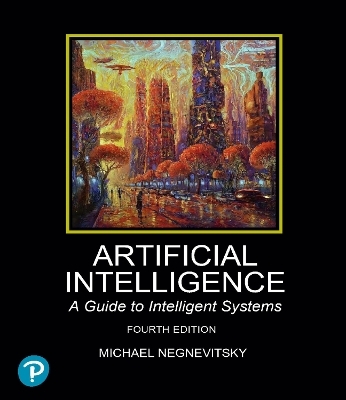
Artificial Intelligence: A Guide to Intelligent Systems
Pearson Education Limited (Verlag)
978-1-292-73085-1 (ISBN)
Unlike many books on computer intelligence, which use complex computer science terminology and are crowded with complex matrix algebra and differential equations, this text demonstrates that the ideas behind intelligent systems are simple and straightforward. This text assumes little or no programming experience as it tackles topics like expert systems, fuzzy systems, artificial neural networks, evolutionary computation, knowledge engineering, and data mining.
Introduction to Intelligent Systems
1.1 Intelligent Machines, or What Machines Can Do
1.2 The History of Artificial Intelligence, or From the ‘Dark Ages’ to Knowledge-based Systems
1.3 Generative AI
1.4 Summary
Questions for Review
References
Expert Systems
2.1 Introduction, or Knowledge Representation Using Rules
2.2 The Main Players in the Expert System Development Team
2.3 Structure of a Rule-based Expert System
2.4 Fundamental characteristics of an expert system
2.5 Forward Chaining and Backward Chaining Inference Techniques
2.6 MEDIA ADVISOR: A Demonstration Rule-based Expert System
2.7 Conflict Resolution
2.8 Uncertainty Management in Rule-based Expert Systems
2.9 Advantages and Disadvantages of Rule-based Expert systems
2.10 Summary
Questions for Review
References
Fuzzy Systems
3.1 Introduction, or What Is Fuzzy Thinking?
3.2 Fuzzy Sets
3.3 Linguistic Variables and Hedges
3.4 Operations of Fuzzy Sets
3.6 Fuzzy Inference
3.7 Building a Fuzzy Expert System
3.8 Summary
Questions for Review
References
Frame-based Systems and Semantic Networks
4.1 Introduction, or What Is a Frame?
4.2 Frames as a Knowledge Representation Technique
4.3 Inheritance in Frame-based Systems
4.4 Methods and Demons
4.5 Interaction of Frames and Rules
4.6 Buy Smart: A Frame-based Expert System
4.7 The Web of Data
4.8 RDF – Resource Description Framework and RDF Triples
4.9 Turtle, RDF Schema and OWL
4.10 Querying the Semantic Web with SPARQL
4.11 Summary
Questions for Review
References
Artificial Neural Networks
5.1 Introduction, or How the Brain Works
5.2 The Neuron as a Simple Computing Element
5.3 The Perceptron
5.4 Multilayer Neural Networks
5.5 Accelerated Learning in Multilayer Neural Networks
5.6 The Hopfield Network
5.7 Bidirectional Associative Memory
5.8 Self-organising Neural Networks
5.9 Reinforcement Learning
5.10 Summary
Questions for Review
References
Deep Learning and Convolutional Neural Networks
6.1 Introduction, or How “Deep” Is a Deep Neural Network?
6.2 Image Recognition or How Machines See the World
6.3 Convolution in Machine Learning
6.4 Activation Functions in Deep Neural Networks
6.5 Convolutional Neural Networks
6.6 Back-propagation Learning in Convolutional Networks
6.7 Batch Normalisation
6.8 Summary
Questions for Review
References
Evolutionary Computation
7.1 Introduction, or Can Evolution Be Intelligent?
7.2 Simulation of Natural Evolution
7.3 Genetic Algorithms
7.4 Why Genetic Algorithms Work
7.5 Maintenance Scheduling with Genetic Algorithms
7.6 Genetic Programming
7.7 Evolution Strategies
7.8 Ant Colony Optimisation
7.9 Particle Swarm Optimisation
7.10 Summary
Questions for Review
References
Hybrid Intelligent Systems
8.1 Introduction, or How to Combine German Mechanics with Italian Love
8.2 Neural Expert Systems
8.3 Neuro-Fuzzy Systems
8.4 ANFIS: Adaptive Neuro-Fuzzy Inference System
8.5 Evolutionary Neural Networks
8.6 Fuzzy Evolutionary Systems
8.7 Summary
Questions for Review
References
Knowledge Engineering
9.1 Introduction, or What Is Knowledge Engineering?
9.2 Will an Expert System Work for My Problem?
9.3 Will a Fuzzy Expert System Work for My Problem?
9.4 Will a Neural Network Work for My Problem?
9.5 Will a Deep Neural Network Work for My Problem?
9.6 Will Genetic Algorithms Work for My Problem?
9.7 Will Particle Swarm Optimisation Work for My Problem?
9.8 Will a Hybrid Intelligent System Work for My Problem?
9.9 Summary
Questions for Review
References
Data Mining and Knowledge Discovery
10.1 Introduction, or What Is Data Mining?
10.2 Statistical Methods and Data Visualisation
10.3 Principal Components Analysis
10.4 Relational Databases and Database Queries
10.5 The Data Warehouse and Multidimensional Data Analysis
10.6 Decision Trees
10.7 Association Rules and Market Basket Analysis
10.8 Summary
Questions for Review
References
Glossary
Index
| Erscheinungsdatum | 28.09.2024 |
|---|---|
| Verlagsort | Harlow |
| Sprache | englisch |
| Maße | 158 x 230 mm |
| Gewicht | 800 g |
| Themenwelt | Informatik ► Theorie / Studium ► Künstliche Intelligenz / Robotik |
| ISBN-10 | 1-292-73085-4 / 1292730854 |
| ISBN-13 | 978-1-292-73085-1 / 9781292730851 |
| Zustand | Neuware |
| Haben Sie eine Frage zum Produkt? |
aus dem Bereich


